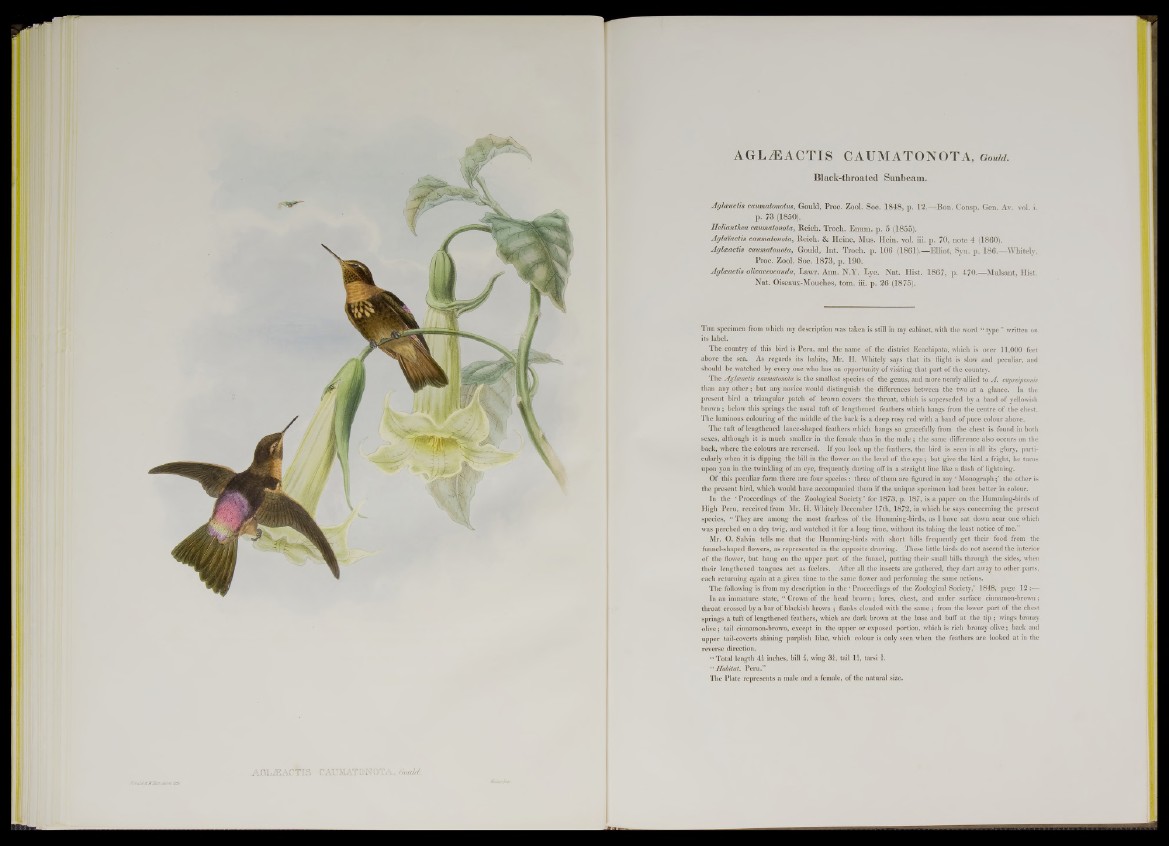
AGLÆACTlî
AGLÆACTIS CAUMATONOT A, Gould.
Black-throated Sunbeam.
Ag loea çtis caumatonotus, Gould, Proc. Zool. Soc. 1 8 4 8 , p. 1 2 .— Bon . Consp. Gen. Av. vol. i.
p . 7 3 (1850).
Helianthea caumatonota, Reich. Troch. Enum. p . 5 (1855).
A g la ia c tia caumatonota, Reich. & H eine, Mus. Hein. vol. iii. p. 7 0 , note 4 (1860).
Agloeaçtis caumatonota, Gould, Int. Troch. p. 1 0 6 (1861).— Elliot, Syn. p. 1 8 6 .— Whitely,
Proc. Zool. Soc. 1 8 7 3 , p. 1 90.
A gloeaçtis olivaceocauda, Lawr. Ann. N .Y . Lyc. Nat. Hist. 1 8 6 7 , p. 4 7 0 .— Mulsant, Hist.
N a t. Oiseaux-Mouches, tom. iii. p. 2 6 (1875).
T he specimen from which my description was taken is still in my cabinet, with the word “ type” written on
its label.
The country o f this bird is Peru, and the name o f the district Ecachipata, which is over 11,000 feet
above the sea. As regards its habits, Mr. H. Whitely says that its flight is slow and peculiar, and
should be watched by every one who has an opportunity of visiting that part o f the country.
The Aglceactis caumatonota is the smallest species o f the genus, and more nearly allied to A . cupreipennis
than any other; but any novice would distinguish the differences between the two at a glance. In the
present bird a triangular patch o f brown covers the throat, which is superseded by a band o f yellowish
brown ; below this springs the usual tuft of lengthened feathers which hangs from the centre o f the chest.
The luminous colouring o f the middle of the back is a deep rosy red with a band of puce colour above.
The tuft o f lengthened lance-shaped feathers which hangs so gracefully from the chest is found in both
sexes, although it is much smaller in the female than in the male ; the same difference also occurs on the
back, where the colours are reversed. If you look up the feathers, the bird is seen in all its glory, particularly
when it is dipping the bill in the flower on the level o f the ey e; but give the bird a fright, he turns
upon you in the twinkling o f an eye, frequently darting off in a straight line like a flash of lightning.
Of this peculiar form there are four species: three o f them are figured in my ‘ Monograph;’ the other is
the present bird, which would have accompanied them if the unique specimen had been better in colour.
In the ‘Proceedings o f the Zoological Society’ for 1873, p. 187, is a paper on the Humming-birds of
High Peru, received from Mr. H. Whitely December 17th, 1872, in which he says concerning the present
species, “ They are among the most fearless of the Humming-birds, as I have sat down near one which
was perched on a dry twig, and watched it for a long time, without its taking the least notice of me.”
Mr. O. Salvin tells me that the Humming-birds with short bills frequently get their food from the
funnel-shaped flowers, as represented in the opposite drawing. These little birds do not ascend the interior
o f the flower, but hang on the upper part of the funnel, putting their small bills through the sides, when
their lengthened tongues act as feelers. After all the insects are gathered, they dart away to other parts,
each returning again at a given time to the same flower and performing the same actions.
The following is from my description in the ‘ Proceedings o f the Zoological Society,’ 1848, page 12:—
In an immature state, “ Crown of the head brown; lores, chest, and under surface cinnamon-brown;
throat crossed by a bar o f blackish brown ; flanks clouded with the same; from the lower part of the chest
springs a tuft of lengthened feathers, which are dark brown at the base and buff at the tip ; wings bronzy
olive; tail cinnamon-brown, except in the upper or exposed portion, which is rich bronzy olive; back and
upper tail-coverts shining purplish lilac, which colour is only seen when the feathers are looked at in the
reverse direction.
“ Total length 4& inches, bill i , wing 3*, tail I f, tarsi $.
“ Habitat. Peru.”
The Plate represents a male and a female, o f the natural size.